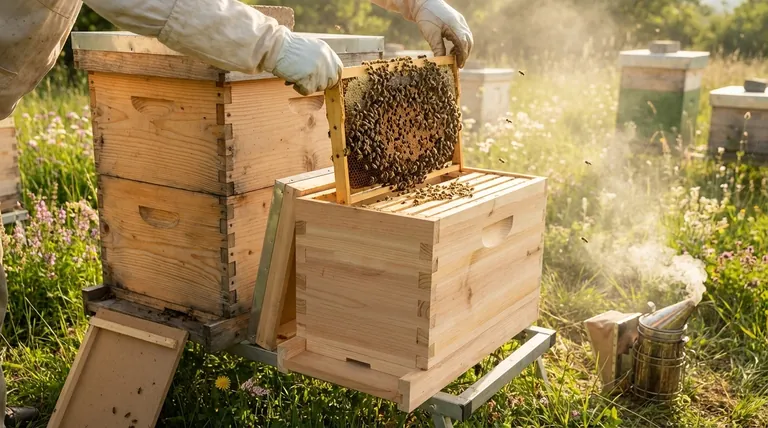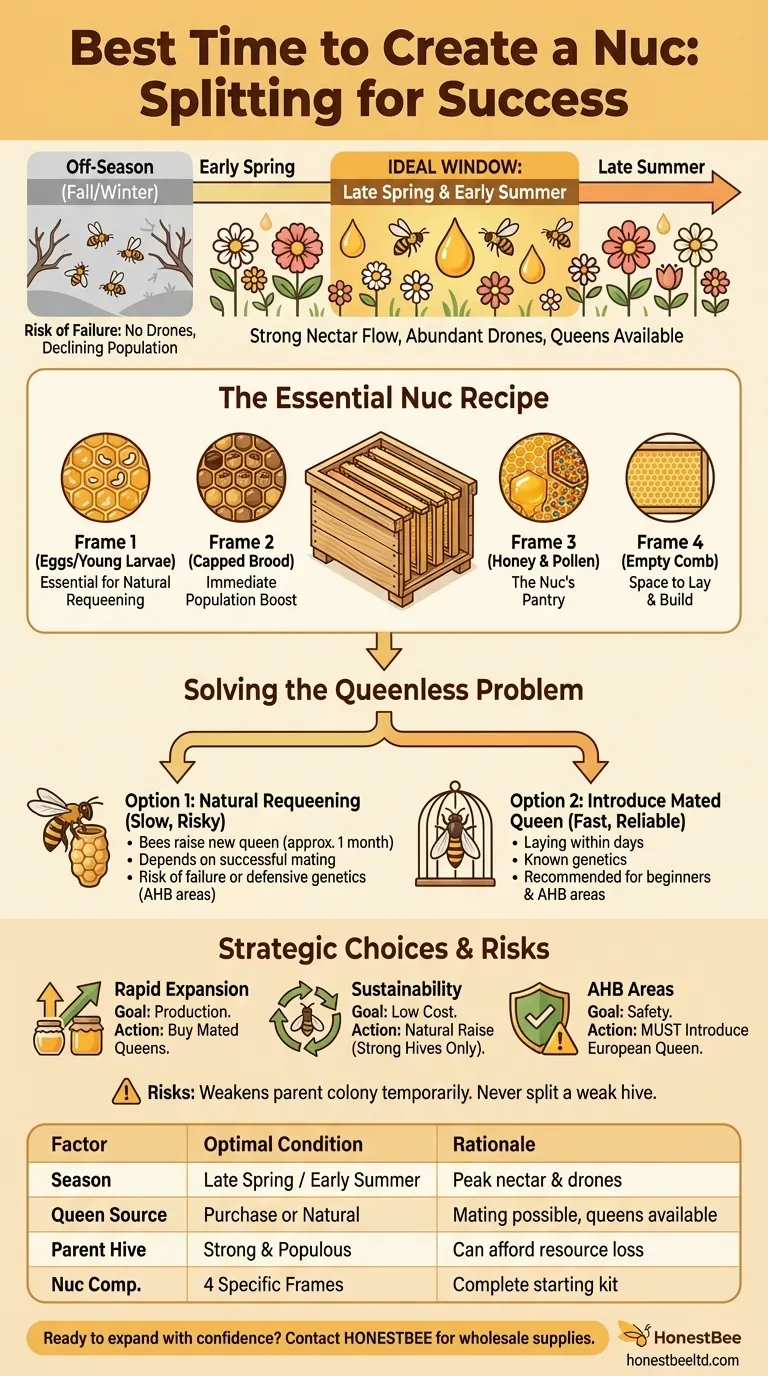The ideal time to create a nucleus colony, or "nuc," by splitting a full-size hive is during a strong nectar flow in late spring and early summer. This period provides the optimal conditions for a new queen to be raised and mated, or for a purchased queen to be accepted, ensuring both the parent colony and the new nuc have ample resources to thrive.
A successful split is not just about dividing bees; it's about ensuring a viable queen for both colonies. Timing is critical because the availability of drones for mating and the supply of commercially raised queens are strictly seasonal, peaking in spring and summer.

Why Timing is Everything: The Queen Factor
The entire success of a split hinges on providing the new, smaller colony with a productive, mated queen. The season dictates your options for achieving this.
The Spring & Summer Advantage
During late spring and early summer, the honey bee world is primed for expansion. Drones (male bees) are plentiful, which is essential for the mating flights of a newly raised virgin queen.
This is also the peak season for commercial queen breeders. You can easily purchase a high-quality, mated queen to introduce into your nuc, dramatically accelerating its development and ensuring known genetics.
The Peril of Off-Season Splits
Attempting to split a colony in the fall or winter is a recipe for failure. There are virtually no drones available, making it impossible for a new queen to mate naturally.
Furthermore, the bee population is naturally declining to conserve resources for winter. A small nuc created in the fall has very little chance of building the population and food stores necessary to survive the cold months.
Anatomy of a Successful Split
A split involves creating a complete, albeit small, new colony. This requires a balanced "recipe" of bees, brood, and food taken from a strong parent hive.
Preparing the Parent Colony
Before you begin, ensure the parent colony is strong, healthy, and populous. A weak hive cannot afford to be split and doing so will likely cause both colonies to fail.
The Essential Nuc "Recipe"
For the best chance of success, your new nuc should contain a specific mix of frames from the parent hive, along with the bees clinging to them:
- One frame of eggs and young larvae: This is non-negotiable if you plan to let the nuc raise its own queen. The bees will select young larvae from these cells to create new queen cells.
- One frame of capped brood: These bees are close to emerging and will provide a critical, immediate boost to the nuc's population.
- One frame of honey and pollen: This is the nuc's pantry. It provides the essential food to fuel the colony while it gets established.
- One frame of empty foundation or drawn comb: This gives the new queen a place to begin laying immediately and gives the workers space to build.
Place these four frames together in a nuc box, ensuring the brood frames are in the center. Add enough bees by shaking another frame or two from the parent hive into the nuc.
Solving the Queenless Problem
A split creates two colonies, but only one can have the original queen. You must have a clear plan for the queenless half.
Option 1: Natural Requeening
If you leave frames with fresh eggs in the queenless colony, the bees will begin "emergency" procedures to raise a new queen. This process is fascinating but slow, taking roughly a month before the new queen is mated and laying.
Option 2: Introducing a Mated Queen
The faster and more reliable method is to introduce a purchased, mated queen. She can begin laying eggs within days, giving the colony a significant head start. This is the recommended approach for beginners and is essential for maintaining gentle genetics.
Understanding the Trade-offs and Risks
Splitting a hive is a powerful management tool, but it is not without its challenges. Understanding the risks is key to mitigating them.
Weakening the Parent Colony
A split temporarily weakens the parent colony by removing bees and brood. This can reduce its honey production for the season. Never split a hive that is not booming with population.
The Risk of a Failed Queen Mating
If you opt for natural requeening, there is always a chance the new queen will be lost on her mating flight or will fail to mate properly. This results in a hopelessly queenless colony that will perish without intervention.
The Africanized Bee Consideration
In regions with Africanized honey bees (AHB), allowing a colony to raise its own queen is risky. Open-mating can result in a new queen that produces highly defensive, aggressive offspring. In these areas, always introduce a mated queen from a reputable breeder.
Making the Right Choice for Your Goal
Your strategy should align with your specific beekeeping objectives.
- If your primary focus is rapid expansion and honey production: Purchase mated queens and introduce them to your splits for the fastest, most predictable results.
- If your primary focus is sustainability and reducing costs: Let your nucs raise their own queens, but only do so from very strong hives during peak spring conditions.
- If you live in an area with Africanized bees: Your only responsible choice is to introduce a mated queen with known European genetics to ensure colony safety and gentleness.
Ultimately, successful colony splitting is an act of proactive management that requires careful timing and a clear understanding of honey bee biology.
Summary Table:
| Key Factor | Optimal Condition | Rationale |
|---|---|---|
| Season | Late Spring / Early Summer | Peak nectar flow; abundant drones for mating. |
| Queen Source | Purchase or Natural Raise | Commercial queens available; natural mating possible. |
| Parent Hive | Strong & Populous | Can afford to lose bees and brood without failing. |
| Nuc Composition | 1 frame eggs/larvae, 1 frame capped brood, 1 frame food, 1 empty comb | Provides everything needed for a new colony to start. |
Ready to expand your apiary with confidence?
HONESTBEE supplies commercial apiaries and beekeeping equipment distributors with the high-quality, wholesale supplies needed for successful splits. From durable nuc boxes to essential hive tools, we provide the reliable equipment that supports your growth.
Contact our team today to discuss your wholesale needs and ensure your splits are built on a foundation of quality.
Visual Guide

Related Products
- 5 Frame Wooden Nuc Box for Beekeeping
- Twin Queen Styrofoam Honey Bee Nucs Mating and Breeding Box
- Automatic Heat Preservation 6 Frame Pro Nuc Box for Honey Bee Queen Mating
- Styrofoam Mini Mating Nuc Box with Frames Feeder Styrofoam Bee Hives 3 Frame Nuc Box
- Portable Bee Mating Hive Boxes Mini Mating Nucs 8 Frames for Queen Rearing
People Also Ask
- What are the benefits of starting a new bee colony in a nuc box? Boost Colony Success with Efficient Beekeeping
- What is the purpose of having a nuc in beekeeping? Build a Resilient & Productive Apiary
- What is the advantage of overwintering a nucleus? A Strategic Asset for Beekeeping Success
- How many frames does a typical wooden nuc box hold? A Guide to Choosing the Right Size
- How should the nuc be installed in the apiary? Ensure Colony Success from Day One



















